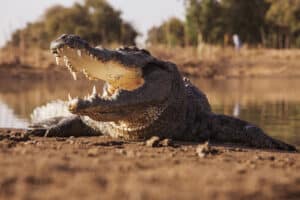There are around 24 species of crocodiles currently on earth. Some crocodile species, like the dwarf crocodile, are small enough to hold, while others, like the saltwater crocodile, can weigh thousands of pounds.
Being semi-aquatic wetlands, rivers, lakes, saltwater, and brackish water are the primary habitats that crocodiles live in. Dens are used by 14 of the 23 extant crocodile species, and here you will discover the massive crocodiles that live in dens 40 feet below the surface.
Most crocodiles that create dens only dig them a few feet underground. Crocodiles are some of the largest reptiles in the world and are also top apex predators in their habitats. Let’s look at the deadly crocodile that can live in dens as deep as 40 feet underground.
The Nile Crocodile – The Deepest Crocodilian Burrower

Nile crocodiles use their large snout and feet to dig out their burrows.
©David Havel/Shutterstock.com
Burrows are used by a variety of crocodile species to lay their eggs and nest. The Nile crocodile is the deepest burrower among all crocodiles and can dig its den up to 40 feet (12.1 meters) deep. Nile crocodiles dig their burrows near the banks of water sources like lakes or rivers.
Nile crocodiles use their large snout and feet to dig out of their burrows. This species not only digs its burrow deeper than other crocodiles, but the Nile crocodile digs the deepest den out of all other burrowing animals. Other burrowing crocodiles only dig their dens a few inches or meters underground.
There are a variety of animals that use burrows, but Nile crocodiles dig some of the deepest dens.
Other burrowing animals:
- Rabbits-10 ft. deep
- Skunks-2 ft. deep
- Beavers-10 ft. deep
- Moles-3.3 ft. deep
- Chipmunks-3 ft. deep
- Wolves-15 ft. deep
- Mice 3.5 ft. deep
Nile Crocodile Mating
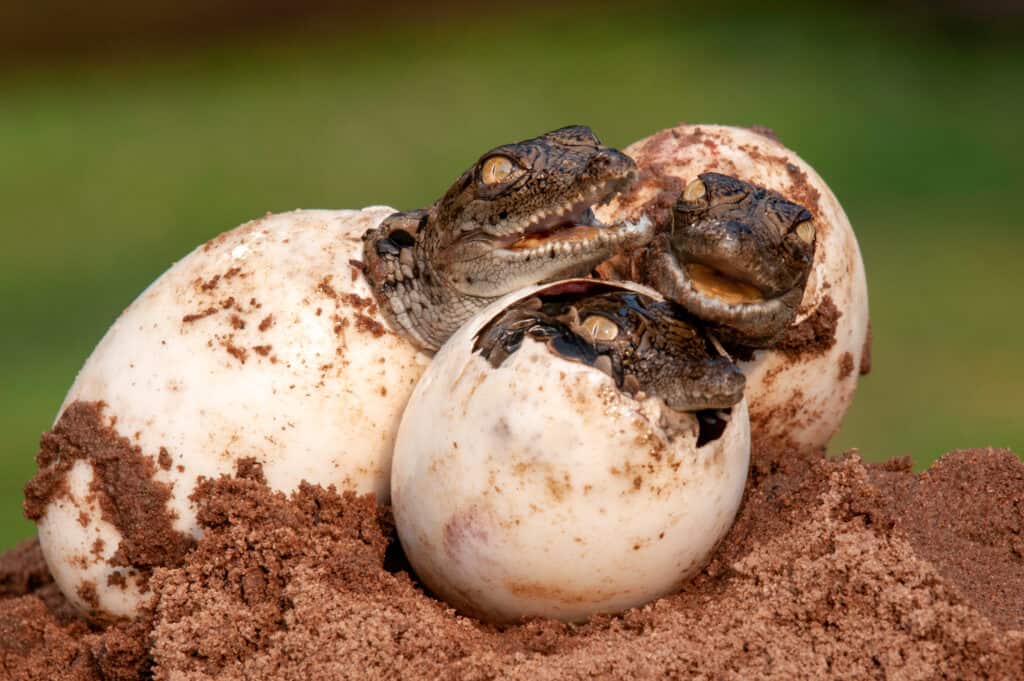
The dens of the Nile crocodile are also used to hide when conditions like temperature are too extreme for them to tolerate.
©Catchlight Lens/Shutterstock.com
The Nile crocodile can lay around 25 to 80 eggs, and their den provides a safe space for them to develop. It takes around 90 days for their eggs to incubate, and the temperatures in their burrows decide the sex of their young. Eggs kept under 31 degrees Celsius will yield a female, and eggs with a temperature ranging from 31 to 34 degrees Celsius yield males.
The dens of the Nile crocodile are also used to hide when conditions like temperature are too extreme for them to tolerate. They dig their dens so large because of their massive size.
Nile crocodiles dig some of the deepest dens. While it is common for animals to use burrows as homes, Nile crocodiles generally only live in their dens when nesting, which occurs in the months between November to February.
When the Nile crocodile’s eggs hatch, they are brought to the water and live together for around 2 years.
Where do Nile Crocodiles Live?
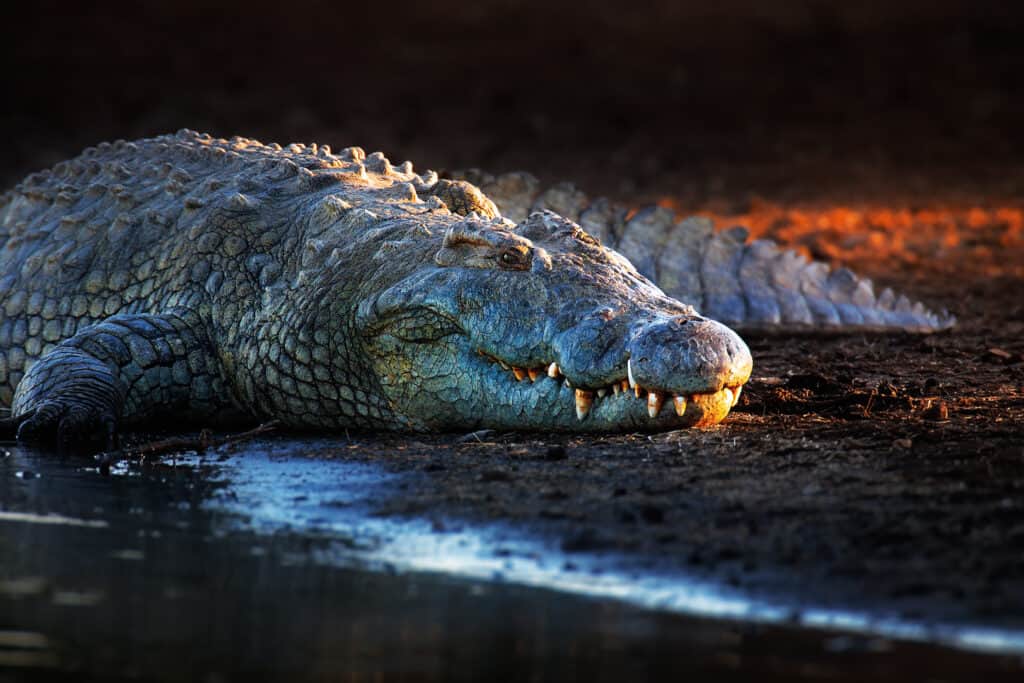
Nile crocodiles can tolerate water with salinity but are rarely found in saltwater habitats.
©Johan Swanepoel/Shutterstock.com
The Nile crocodile lives in the swamps, rivers, mangroves, and other freshwater habitats within sub-Saharan Africa. This species’ range stretches across Africa’s eastern, southern, and central regions and can be found in 26 countries. Nile crocodiles can tolerate water with salinity but are rarely found in saltwater habitats.
Nile crocodiles are nocturnal, and they can be seen sunbathing on the shore or resting in the water during the day. Central Africa contains the largest population of Nile Crocodiles. With a healthy population estimated between 250,000 to 500,000, this crocodile species status is listed as “least concern.” The Nile crocodile is one of the most common crocodiles in Africa and a rare invasive species in Florida.
How Large is the Nile Crocodile?

The Nile crocodile has an average weight of between 500 to 1,700 lbs.
©ShutterOK/Shutterstock.com
While digging one of the deepest burrows, the Nile crocodile is also one of the largest animals that inhabit dens. As one of the largest extant reptilians, the Nile crocodile has a length between 9.8 to 15 ft. Males are around 30% larger than females, and the largest Nile crocodiles can reach up to 20 feet long.
The Nile crocodile has an average weight of between 500 to 1,700 lbs. The largest of these species can grow over 2,000 lbs, and they are one of the longest crocodiles in the world. Nile crocodiles are the second largest crocodile species and are nearly as large as the saltwater crocodile.
They are apex predators in the habitats they live in. Thick scales cover their bodies, and knife-like teeth fill their mouth. The color of this reptile ranges from dark green to olive brown, allowing them to blend into murky waters easily.
What Do Nile Crocodiles Eat?
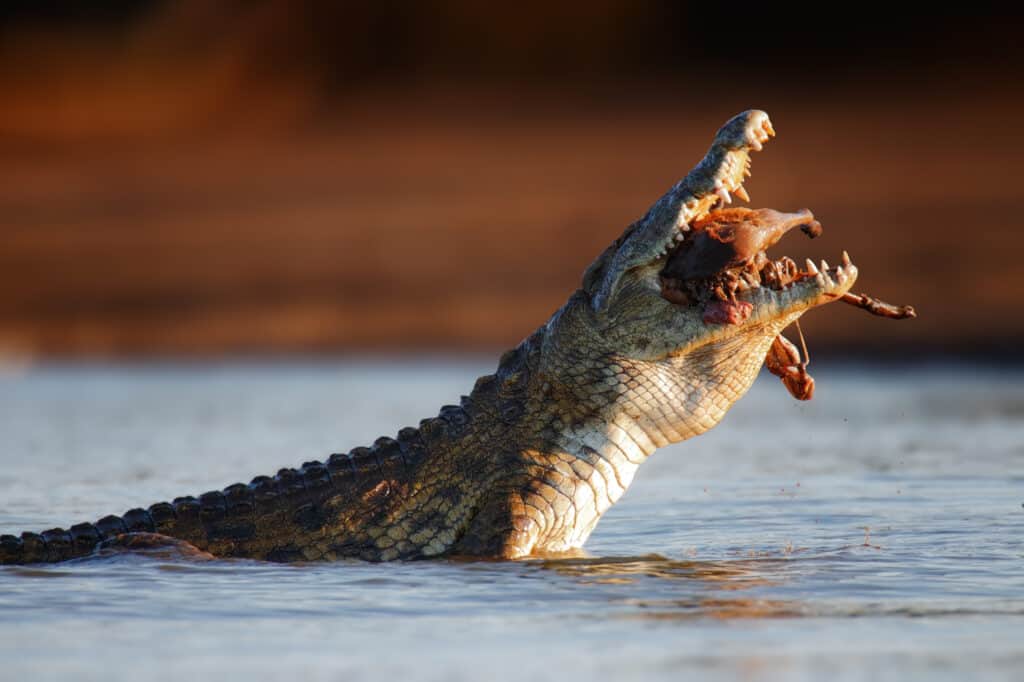
Nile crocodiles ambush their prey and usually hunt near the shores of waters.
©Mari Swanepoel/Shutterstock.com
Fish are what the Nile crocodile eats the most, but this carnivore will feed on anything it can overpower. When first leaving its den, juvenile Nile crocodiles hunt together in groups, and as they age, they become more solitary. Birds, zebras, gazelle, small hippos, and other similar animals are what this crocodile eats. They have a powerful bite force of 5,000 psi, which is around 5 times stronger than a lion.
Nile crocodiles ambush their prey and usually hunt near the shores of waters. Even with their size, the Nile crocodile only eats around 50 meals a year. These massive crocodiles are extremely dangerous and kill up to 200 people annually. The Nile crocodile typically lives around 50 to 60 years; a massive reptile that digs deep dens.
Lifespan
Nile crocodiles are one of the longest-living species, with an expected lifespan of up to 70 years in the wild and 90 years in captivity. However, their numbers have been declining due to habitat loss, hunting for commercial and recreational purposes, pollution, disease, overfishing by humans, and competition from other predators. As a result of these threats, they are now listed as vulnerable on the IUCN Red List of Threatened Species. Conservation efforts such as captive breeding programs have been set up in order to help increase their numbers in the wild.
Nile Crocodile vs Saltwater Crocodile
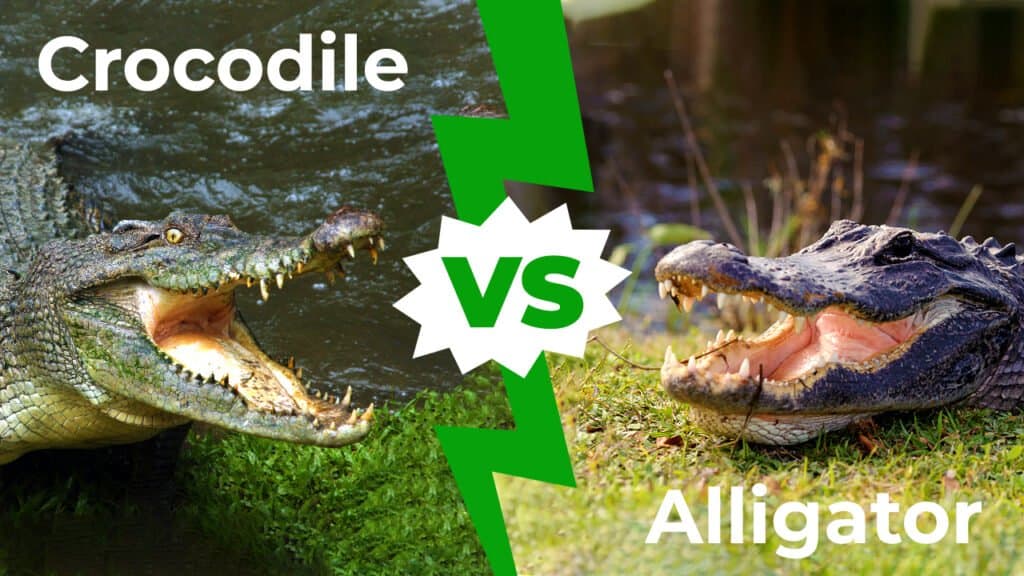
How does the Nile crocodile compare to the Saltwater crocodile? In size, the Nile crocodile can reach up to 2,400lbs in weight, while the Saltwater can reach up to 2,200. The Saltwater croc can reach a greater length of up to 23ft or more, compared to 21ft for the Nile croc.
Their colorations differ, with the Nile croc having a bronze color on top of its body with yellowish-brown on its sides, versus the Saltwater, which has a greenish color on top, with tan or gray colors on the side, and yellowish or white underside. The Saltwater Croc also has a wider snout than the Nile.
Location and habitat play a big part in how these crocodiles differ. Nile crocodiles are not only located in sub-Saharan Africa, including Madagascar, but it’s suspected that a population of them may be growing in the U.S. While Nile crocs can tolerate saltwater, they are usually found in freshwater habitats like rivers, streams, tidal lakes, and estuaries. Saltwater crocodiles, on the other hand, inhabit coastal areas in eastern India, Southeast Asia, and Australia. They can also be found in rivers and mangrove swamps but tolerate saltwater much better than Nile crocs. They are able to spend longer periods of time at sea swimming between islands and countries.
While saltwater crocodiles do dig burrows in river banks to hibernate in colder months, they don’t burrow as deeply as the Nile crocs do.
The photo featured at the top of this post is © Johan Swanepoel/Shutterstock.com
Sources
- Blue Planet Biomes , Available here: https://www.blueplanetbiomes.org/nile_crocodile.php
- Crocodiles of the World, Available here: https://www.crocodilesoftheworld.co.uk/conservation/conservation-status/
- SeaWorld Parks & Entertainment, Available here: https://seaworld.org/animals/facts/reptiles/nile-crocodile/
Thank you for reading! Have some feedback for us? Contact the AZ Animals editorial team.





